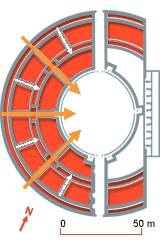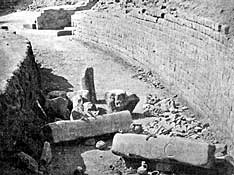- Home
- The city
- The early Roman city
- The amphitheatre
- The cavea
Spectators reached the rows of seats via two types of vomitoria.
3D graphics: © A.-B. Pimpaud.
Map of the cavea.
© D. Busson et V. Charlanne.
Inscribed stone blocks
Not a single row of seats in the cavea was found in situ. However, four stone blocks with inscriptions were found when the edifice was demolished. Similar blocks were discovered in the Île de la Cité, reused in the foundation of the Late Roman city wall. These blocks are thought to have come from the amphitheatre. Some, if not all, of these inscriptions are proper names or initials. They may be parts of the seating that bore the names of the seat holders.
The reconstruction
These discoveries do not allow us to reconstruct with any certainty the division of the seating into maeniana separated by walkways-there are many uncertainties concerning the circular walls on which the rows of seats rested. In addition, we cannot rule out the fact that the blocks that were found may have come from two different states of the structure. The various reconstructions that have been proposed-particularly that of Jules Formigé-remain largely theoretical. Nevertheless, the seating capacity of the structure has been estimated at 17,000.
Access and circulation
Spectators reached the rows of seats via two types of vomitoria. Three large vomitoria led to the podium seats and the first maenianum. They alternate with four smaller vomitoria. According to J. Formigé's reconstruction, the second and third maeniana were reached by steps and by the smaller vomitoria. The podium seats could be reached by the small strairways set in the cavea's internal wall. A gallery, probably connected to the outside of the edifice by a series of passages, gave access to the vomitoria.
Inscribed blocks discovered at the site, probably from the seats.
© Ch. Normand, 1897.


